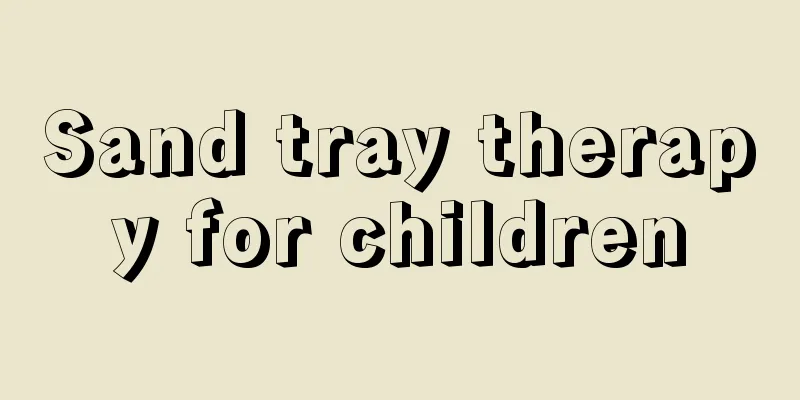Sand tray therapy for children

|
With the improvement of living standards, people pursue better material needs. At this time, most of their time is often spent on work, and their children's lives are often neglected. At this time, children often have psychological problems. Psychologists in modern society have also discovered this situation and invented sandplay games for psychotherapy. Today, let's take a look at what sandbox games are and what impact sandbox games have on children's psychology?
The name "sand-tray and sand-play" gives three "keywords": "sand", "tray" and "game". First of all, children like sand and seem to have some kind of natural feeling for it. Almost all kindergartens have "sand play areas" and "water play pools", which are also games involving sand. Two plates, one for sand and one for water. Lowenfeld did just that when he started out. The sandbox modified by Kalff has sand in both, but one of them is used for "dry sand games" while the other can be added with water, which is called "wet sand games". A wet sandbox makes it easier to play games such as building castles, digging holes and building bridges. Playing is children's nature. Therefore, the game contains the restoration and obstruction of nature, and therefore, the conditions and opportunities for treatment and healing can be obtained in the game.
1. Psychotherapy As a comprehensive psychotherapy system, especially as a mainstream development that combines psychoanalytic techniques with art and expressive psychotherapy, sandplay has been widely used in psychological counseling, psychological assessment, psychotherapy, psychological education, human resource development and EAP, as well as many fields of professional psychoanalysis; especially the combination of sandplay and school psychological education has achieved important development in our country. The main functions and effects of sandplay games include: psychological diagnosis and comprehensive psychological assessment; counseling and relief of various psychological pressures, tensions and anxieties; professional psychological analysis and cure of various psychosomatic diseases; at the same time, sandplay game therapy can also be used as a comprehensive psychological education technology, which can play a positive role in the maintenance of mental health and personality development, the cultivation of artistic expression and creativity, and the improvement of quality of life, guiding visitors to obtain personality development and mental perfection with self-individuation as the goal, and feel the realm that the mind can reach. 1.1 Application of sandplay in child psychotherapy Since the advent of sandplay, it has gradually gained praise from the international clinical psychology community and is recognized as one of the most effective psychotherapy methods. Compared with traditional child psychotherapy, sandplay is particularly suitable for children and has been widely used in the treatment of many children's mental illnesses both at home and abroad. Post-traumatic stress disorder (PTSD) in children is a good indication for sandplay. PTSD refers to a persistent anxiety state that occurs after children suffer severe traumatic experiences and is one of the common emotional disorders in children. Trauma refers to catastrophic events, including various forms of abuse or natural and man-made disasters. Such traumatic experiences, especially abuse experiences, are particularly difficult for children to acknowledge and even more difficult to express in words.
Sandbox games have gradually begun to enter schools and are used in school mental health education. The working principle of sandplay is not simply to treat the psychological symptoms of children as the working goal, but to focus more on the enrichment and development of their inner psychology. It plays a positive role in the healthy growth of children, such as cultivating self-confidence and personality, developing imagination and creativity, etc. Therefore, it is particularly in line with the basic principles of psychological education and has opened up a new path for school psychological education. According to some empirical studies at home and abroad, sandplay has a good effect, especially for children who have problems such as anxiety, difficulty concentrating, difficulty in verbal communication, and difficulty in adapting to school. Chen Shunsen et al. conducted a series of intervention experiments to examine the effect of sandplay games on alleviating test anxiety among middle school students and compared it with the effect of relaxation training. The results showed that sandplay games can effectively intervene in the test anxiety of junior high school students, just like relaxation training, and the maintenance of the intervention effect is better than relaxation training. Lin Mingqing from Taiwan used sand tray games to treat a child with attention deficit hyperactivity disorder. After 16 treatments, he found that the child's problems such as inattention, hyperactivity and impulsivity had improved significantly. Motoko Sakurai and others tried to use sandplay on all students in an Australian school for children with severe language disorders and found that sandplay had a good effect on improving these children's verbal communication and interpersonal skills. Through a series of sandplay interventions on kindergarten children, it was found that sandplay is a positive and affirmative way to help children with adjustment disorders relieve negative emotions and ease inner conflicts. Most children find it difficult to express and vent their psychological anxiety, stress and helplessness in words. These stresses and negative emotions cause children to exhibit various emotional, behavioral or adaptation problems. Although these problems do not meet the diagnostic criteria for mental disorders, they have a great impact on students' physical and mental health and personality development. Sandplay provides these children with an effective way to express and release their emotions. By playing with sand and toy models, they can not only relax their body and mind by freely venting their negative emotions, but also reconstruct their conscious or unconscious cognition through the sandplay, activate their own health and healing factors, and thus gain mental cultivation and sound development of personality. |
<<: Why does my baby sleep with his mouth open?
>>: 3-year-old baby vomits and has abdominal pain but no fever
Recommend
The baby can't roll over at 4 months old
Every change in the baby after birth is watched b...
Newborns don't cry when they are hungry
When babies cannot speak, they will cry to attrac...
What medicine should I use to remove scars from burns on children?
Most children are naughty in life, so parents sho...
What is the reason why the baby wakes up crying during sleep?
For babies, crying seems to be a common occurrenc...
What are the pimples on children's noses?
Children's body resistance is relatively low ...
How to ensure that your baby gets hind milk
The health of the baby is a topic that every pare...
Why is my six-month-old baby coughing?
If your child at home has a cough, you must make ...
What to do if your child has bladder stones
In recent years, due to environmental pollution, ...
How to quickly relieve the pain of a child's stomachache
Not only are young children unable to take care o...
Infant and young child exanthema symptoms and care
When caring for infants and young children, you m...
Yellow palate in newborns
Many newborns have symptoms of yellow palate, whi...
What are the dangers of using cough plaster on children?
When a child has symptoms of coughing, parents of...
Seven month old baby sleeping time
The amount of sleep a baby needs varies from mont...
Why does my baby have a gurgling throat when he has a fever?
Babies are very susceptible to illness due to the...
Baby's back is sweaty and cold
If you find that your baby's back is sweating...









